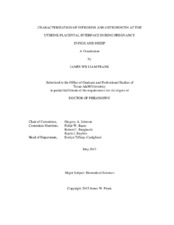| dc.description.abstract | Establishment of a successful pregnancy is dependent upon proper communication between the conceptus and uterus and provides the critical physiological and anatomical groundwork required to maintain growth and development of the conceptus throughout pregnancy. Osteopontin (OPN) is a soluble extracellular matrix (ECM) protein that interacts with multiple integrin receptors. Integrins are integral membrane proteins that promote cell-to-cell and cell-to-ECM adhesion, cytoskeletal reorganization, and signal transduction through a structure known as a focal adhesion (FA). Osteopontin, and multiple integrins that bind OPN, are observed on the apical surfaces of both trophectoderm (Tr) and uterine luminal epithelium (LE) during pregnancy in pigs and sheep. During the period of implantation in these species, conceptuses elongate and attach to the uterine LE. Placentation creates a unique physiological phenomenon wherein the apical surfaces of two epithelia adhere to one another for an extended period of time. Research for this dissertation investigated interactions between integrins and OPN at this unique interface. We hypothesized that FAs form in response to mechanical stress at the uterine-placental interface and utilize OPN as a bridging ligand to anchor placenta and uterine LE together in pigs and sheep during pregnancy. In the pig ITGAV and ITGB3 subunit proteins aggregate in vivo to form FAs during the peri-implantation period of pregnancy. As the uterine-placental interface becomes more folded during placentation, these FAs are no longer observed. We hypothesize that FAs are no longer necessary because folding disperses forces exerted across this interface. In the sheep, FAs containing integrins ITGAV, ITGA4, ITGA5, ITGB1, and ITGB5, which co-localize with OPN, increase in quantity and organization at the uterine-placental interface as pregnancy progresses. However, ITGB3 is only present during the peri-implantation period of pregnancy. The in vivo knockdown of ITGB3 subunit leads to a smaller fetus with decreased OPN and nitric oxide synthase 3 (NOS3) mRNA expression in the placenta of growth retarded fetuses. Additionally, OPN is localized near vascular networks in the placenta during normal sheep pregnancy. These results suggest that delayed embryonic growth in sheep due to ITGB3 knockdown is related to impaired vascular function and/or angiogenesis. In conclusion, integrins and OPN play a crucial role in maintaining attachment of Tr to uterine LE at the uterine-placental interface in response to mechanical forces which are required for normal fetal-placental growth during pregnancy in pigs and sheep. | en |


